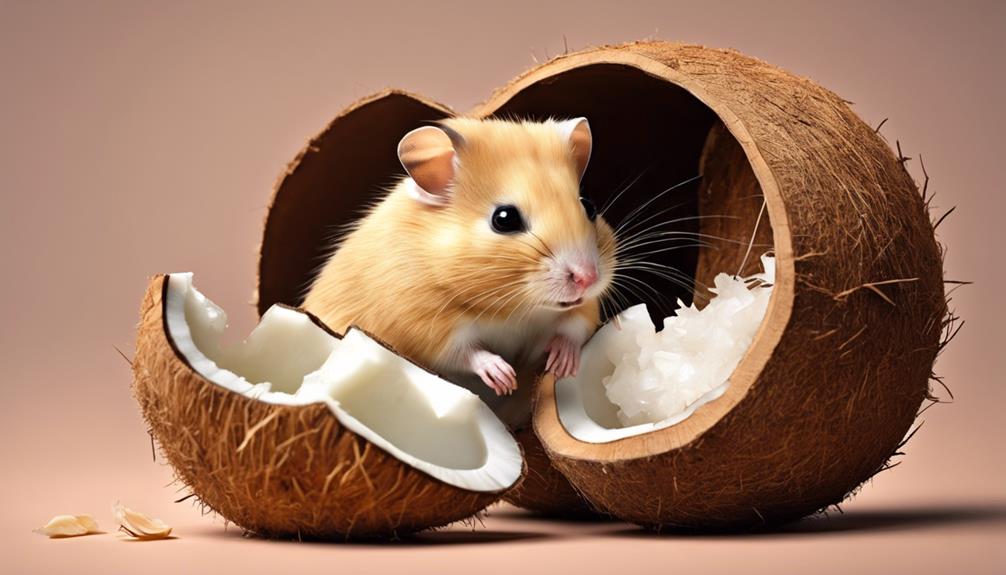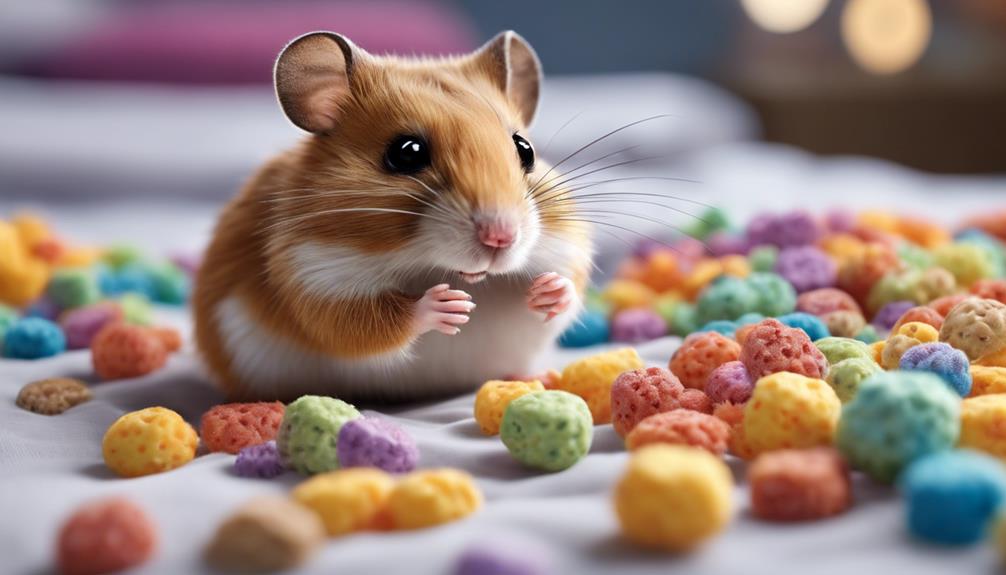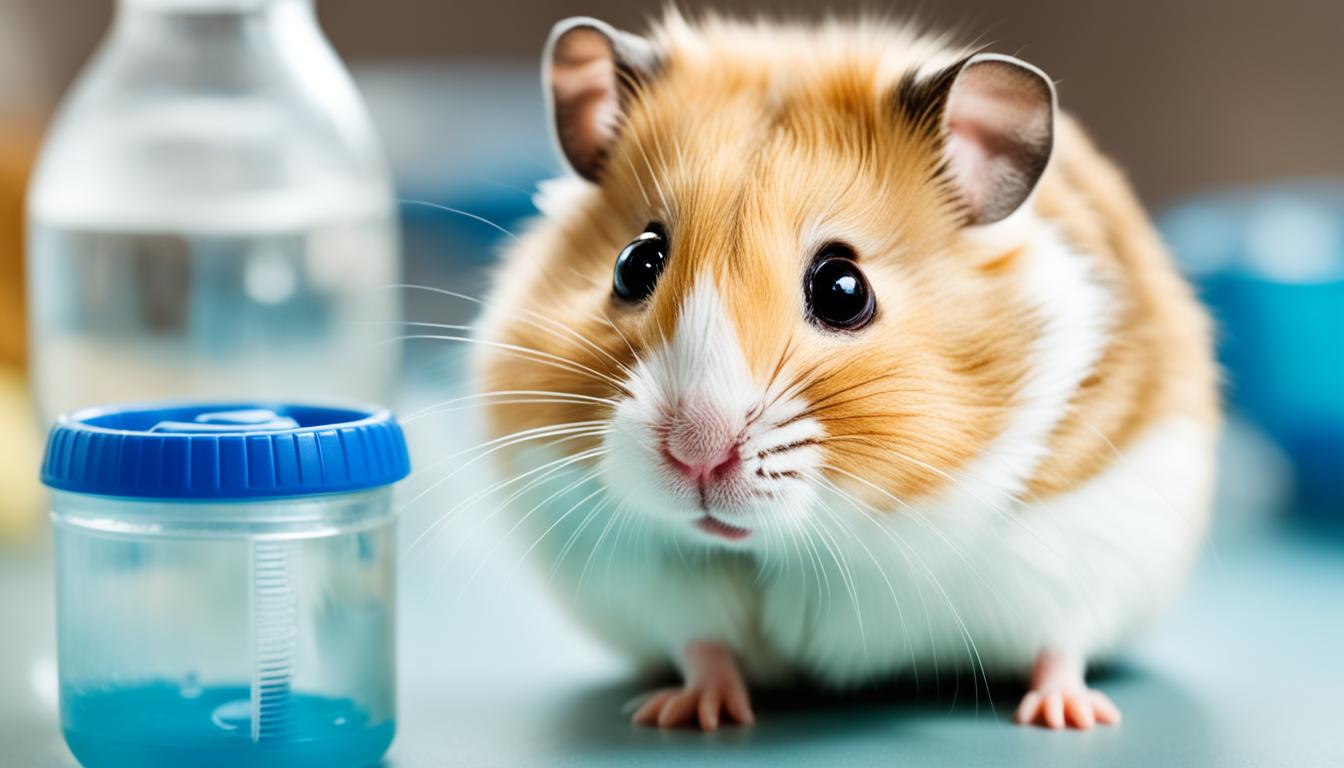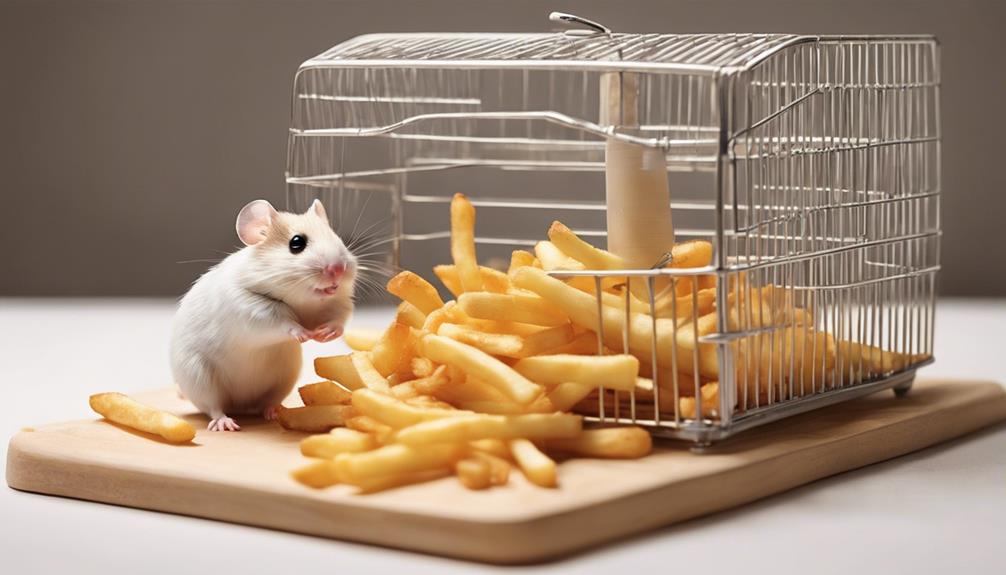When giving hamsters coconut as a snack, it’s important to offer fresh coconut flesh without the shell in moderation because of its high fat content. Fresh coconut provides more nutrients compared to dried coconut flakes, which should be given sparingly. Always remember to remove the coconut shell before feeding it to your hamster and ensure that it is fresh and free of additives to promote optimal hamster health.
Keep an eye out for allergic reactions, monitor stool consistency, and watch their weight and activity levels. If you want to guarantee your furry friend’s well-being and discover more tips for safely feeding coconut, we have all the information you need.
Key Takeaways
- Offer fresh coconut flesh without the shell for higher nutrition.
- Feed coconut in moderation due to its high fat content.
- Remove coconut shells before feeding to prevent choking hazards.
- Monitor hamsters for allergic reactions or digestive issues.
- Consult a vet if hamsters show signs of discomfort after consuming coconut.
Nutritional Benefits of Coconut for Hamsters
Coconuts offer a variety of essential nutrients important for enhancing the overall health and well-being of hamsters. These furry friends benefit greatly from the nutritional value that coconut provides. Including coconut in their diet can contribute to a balanced diet, promoting healthy digestive systems and supporting their immune system. Hamsters can enjoy the benefits of fresh foods like coconut, which are rich in essential nutrients important for their well-being.
Moreover, the electrolytes present in coconuts aid in hydration, ensuring hamsters maintain proper fluid balance. The healthy dietary fats found in coconut can also promote skin and fur health, keeping them looking and feeling their best. Additionally, the antioxidants in coconut play a significant role in supporting hamsters’ immune systems, safeguarding their overall health.
Incorporating coconut into your hamster’s diet can be a great way to provide them with the necessary nutrients for excellent health and well-being.
Safe Ways to Offer Coconut to Hamsters
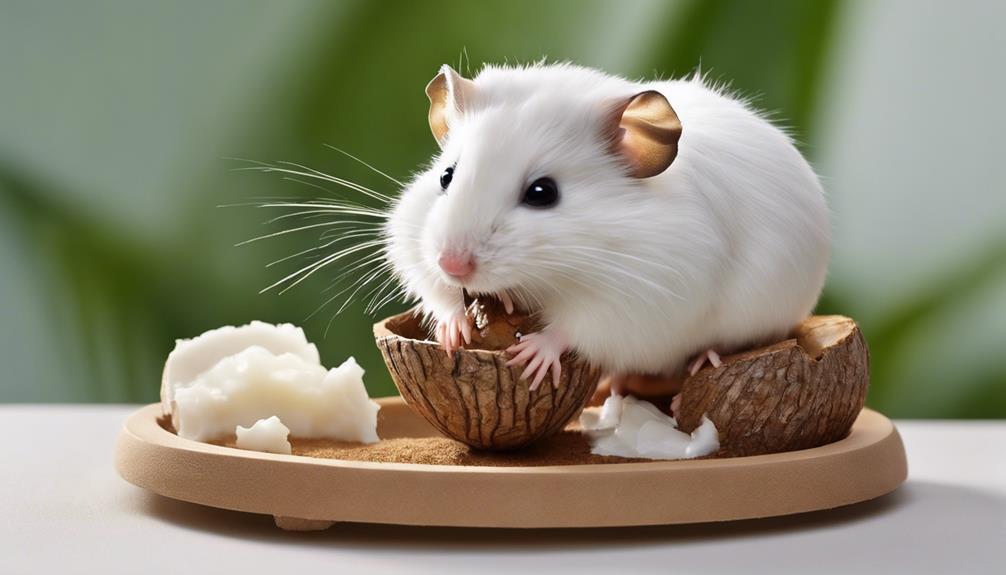
When offering coconut to hamsters, it’s important to provide fresh coconut flesh without the shell to avoid any potential choking hazards. Fresh coconut offers a higher nutritional value compared to dried coconut, making it a healthier treat for your hamster.
Because of its high fat content, it’s essential to feed coconut in moderation. Offering a small amount as an occasional treat can prevent constipation and guarantee your hamster enjoys the benefits of the coconut without any adverse effects.
Additionally, avoid giving hamsters coconut shells to guarantee safe consumption. Proper feeding of coconut involves ensuring that it’s fresh, free from any additives, and provided in a way that minimizes any risks.
Portion Control Guidelines for Feeding Coconut
Effective portion control is essential when incorporating coconut into a hamster’s diet to ensure their well-being and nutritional balance. When it comes to feeding coconut to hamsters, it’s vital to offer it in moderation. Adult hamsters can enjoy a small piece of fresh coconut meat, approximately an inch in size, as an occasional treat. Dried coconut flakes, on the other hand, should be given sparingly, with about a teaspoon once or twice a week being sufficient.
It is important to remember that coconut is high in fat, so portion control is vital to prevent any health issues in hamsters. A suitable amount to offer is around 1 gram of coconut per day. Additionally, always remember to remove the coconut shell before feeding it to your hamster to avoid any potential dental problems.
Alternatives to Coconut for Hamster Treats
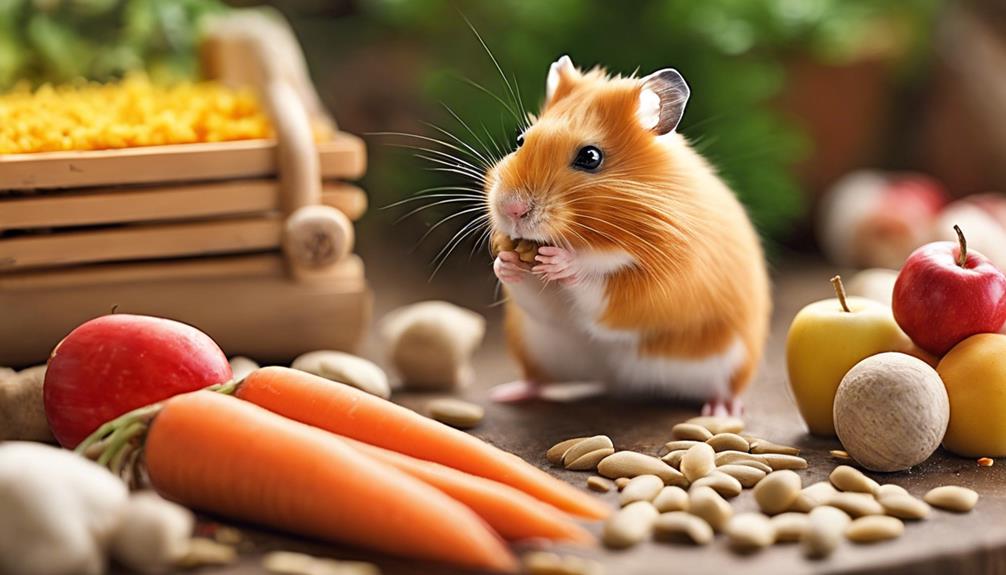
To provide a vital diet for your hamster, exploring alternative treats to coconut can offer a variety of nutritious options. Apples, pears, and berries are excellent fruit choices that can be enjoyed by your pet. These fruits provide essential vitamins and minerals that help keep your hamsters healthy. Additionally, carrots, cucumbers, and bell peppers are low-calorie vegetable options that can be fed in small amounts to aid in digestion and offer variety in their diet.
While coconut can be a tasty snack for your pet, it’s important to remember that commercial hamster food should make up the bulk of their diet, with treats like coconut reserved for occasional indulgences. Opt for fresh fruits and veggies to guarantee a balanced nutrition plan for your furry friend. Remember to avoid sugared or candied coconut products due to their high sugar content, which can be harmful to your pet’s digestive system. Providing a mix of treats won’t only keep your hamster happy but also promote their overall well-being.
What Is Coconut What Is the Nutritiv Content of Coconut
The nutritional content of coconut, specifically the coconut meat or the white flesh inside a coconut, is rich in several nutrients. A cup (80 grams) of fresh, shredded coconut meat contains:
- Calories: 283
- Protein: 3 grams
- Carbs: 10 grams
- Fat: 27 grams
- Sugar: 5 grams
- Fiber: 7 grams
- Manganese: 60% of the Daily Value (DV)
- Selenium: 15% of the DV
- Copper: 44% of the DV
- Phosphorus: 13% of the DV
- Potassium: 6% of the DV
- Iron: 11% of the DV
- Zinc: 10% of the DV
Coconut meat is exceptionally high in calories, saturated fat, and fiber. It also contains a variety of minerals, including manganese, copper, selenium, phosphorus, potassium, and iron. The fat in coconut meat is notable for being high in medium-chain triglycerides (MCTs), which are absorbed intact in the small intestine and used by the human body to produce energy.
Monitoring Hamsters While Eating Coconut
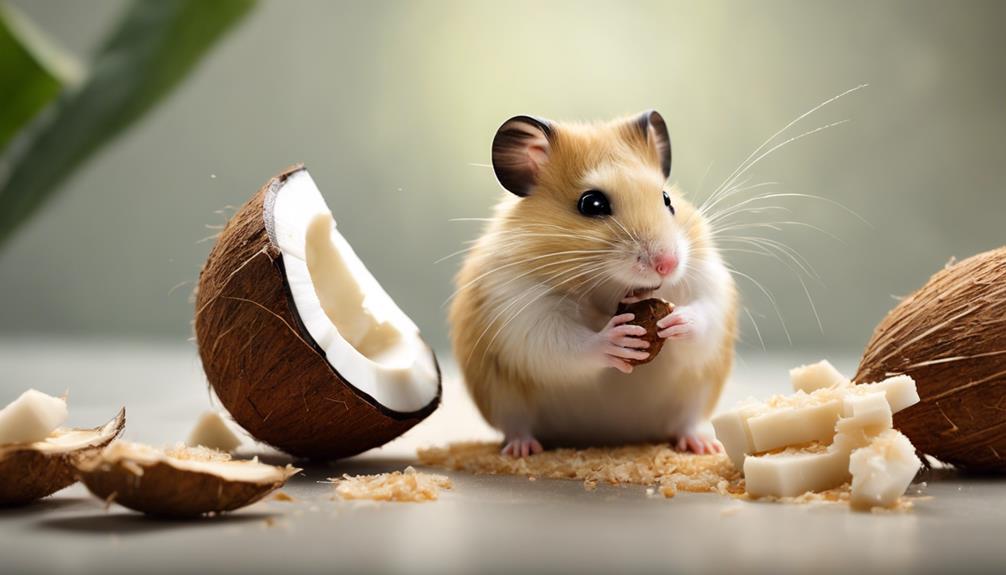
Keeping a close eye on hamsters while they’re eating coconut is essential to guaranteeing their well-being and health. When offering coconut treats to your hamster, watch for any signs of allergic reactions such as itching or swelling. It’s vital to monitor their stool consistency and digestive functions after consuming coconut to detect any adverse effects. Additionally, observe your hamster’s weight and activity levels to make sure that the amount of coconut provided suits their dietary needs.
Pay attention to any reluctance or aversion your hamster may show towards coconut treats, as this could indicate a preference for other foods. Be vigilant for any unusual behaviors or symptoms post-consumption that may suggest a negative reaction to coconut. If your hamster displays any concerning signs, such as decreased appetite or lethargy, consult with a veterinarian promptly. By closely monitoring your hamster’s response to coconut, you can better understand their dietary preferences and secure their overall well-being.
Frequently Asked Questions
Are Coconut Hides Safe for Hamsters?
Indeed, coconut shelters are secure for hamsters. They offer enrichment and nesting possibilities. Verify hides are tidy and devoid of sharp edges. Supervise interactions to avoid mishaps. Coconut shelters are a natural and engaging addition to a hamster’s environment.
Can I Put a Coconut Shell in My Hamster Cage?
Absolutely, we can definitely place a coconut shell in the hamster cage. It’s a fun addition for them to explore and interact with. Just make sure it’s clean, smooth, and regularly checked for safety.
Does Hamster Eat Coconut?
Yes, hamsters can eat coconut. It provides essential nutrients like fiber and healthy fats. Introduce coconut gradually as a treat, making sure it is fresh and shell-free. Monitor for any adverse reactions to guarantee your hamster’s well-being.
Is Coconut Oil Safe for Hamsters Skin?
Yes, coconut oil is safe for hamsters’ skin. It can enhance skin health, give a shiny coat, and has antimicrobial properties. Using high-quality, organic coconut oil without additives is essential. Always consult a vet for safety.
Can Hamsters Eat Both Coconut and Bell Peppers Safely?
Yes, hamsters can eat both coconut and bell peppers safely. However, it’s essential to practice safely feeding hamsters bell peppers in moderation, as too much can upset their stomach. Offer small bits as occasional treats and always remove any uneaten portions to keep their habitat clean.
Conclusion
To sum up, offering coconut as a treat for hamsters can be a delightful and nutritious addition to their diet. By following safe feeding practices and monitoring their consumption, we can guarantee our furry friends enjoy this tropical snack in moderation.
Remember to provide a variety of treats and always prioritize the health and well-being of your hamster.
Happy snacking!
